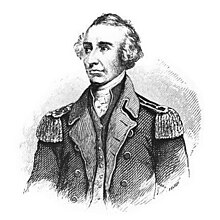General Francis Marion
| Francis Marion | |
|---|---|
 |
|
| Nickname(s) | "Swamp Fox" |
| Born | c. 1732 Berkeley County, South Carolina |
| Died | February 27, 1795 (aged c. 63) |
| Place of burial | Belle Isle Plantation Cemetery Saint Stephen, South Carolina |
| Allegiance |
|
| Service/branch |
|
| Years of service | 1757–1782 |
| Rank |
Lieutenant colonel, brigadier general |
Francis Marion (c. 1732 – February 27, 1795) was a military officer who served in the American Revolutionary War. Acting with the Continental Army and South Carolina militia commissions, he was a persistent adversary of the British in their occupation of South Carolina in 1780 and 1781, even after the Continental Army was driven out of the state in the Battle of Camden.
Marion used irregular methods of warfare and is considered one of the fathers of modern guerrilla warfare and maneuver warfare, and is credited in the lineage of the United States Army Rangers. He was known as The Swamp Fox.
Francis Marion was born on his family's plantation in Berkeley County, South Carolina, c. 1732. Around the age of 15, he was hired on a ship bound for the West Indies which sank on his first voyage; the crew escaped on a lifeboat but had to spend one week at sea before reaching land. During the following years, Marion managed the family's plantation.
Marion began his military career shortly before his 25th birthday. On January 1, 1757, Francis and his brother, Job, were recruited by Captain John Postell to serve in the French and Indian War and to drive the Cherokee Indians away from the border. In 1761, Marion served as a lieutenant under Captain William Moultrie in a campaign against the Cherokee using scorched earth tactics, destroying many Indian villages and burning crops to starve the Cherokee into submission.
On June 21, 1775, Marion was commissioned captain in the 2nd South Carolina Regiment under William Moultrie, with whom he served in June 1776 in the defense of Fort Sullivan (today known as Fort Moultrie), in Charleston harbor.
...
Wikipedia
